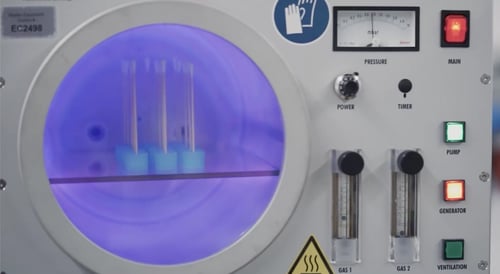
Surface energy - Increasing adhesive properties and activating surfaces
The surface energy of a surface is defined as the excess of energy at the surface of the material compared to the bulk (rest of the material). If the surface has a high surface energy it can be said to have good adhesive properties, but if the surface has low surface energy then it could be said that the surface has poor adhesive properties, to increase the surface energy one will have to activate the surface.
Surface activation is done through plasma treatment. The treatment begins with the excitement of a combination of gases as they enter the chamber, forming plasma. Ions are formed from the excited molecules in the gases breaking free from one or two of the electrons orbiting the atom; electrons that were freed can also bond with other molecules to form a positive ion. All of the ions, molecules and electrons combined in the chamber will give the plasma a net charge of zero, though the negatively charged electrons will be the particle to bombard the surface in the chamber, breaking apart the existing bonds at the atomic surface creating new sites for bonding. With the creation of the new bonding sites, the surface energy has been activated. This shall allow the adhesion of inks, coatings, and adhesives. Because of the treatment many materials have become more versatile.
Businesses have started adapting plasma treatments as part of their production steps. Plasma is a low cost, but highly efficient, treatment method for easy alterations of materials. Products shall perform perfectly to design specifications post treatment; the paints, inks, and adhesives shall stick to the surface, product inside a container can be dispensed with ease, or placing a protective layer on the outer most surface of any surface. When compared to the other methods plasma is the safest treatment in any industry. No dangerous chemicals or acids need to be stored or used on site.
Surface Energy is the energy excess the surface of a material has compared to the bulk; it is measured in J/m². It is caused by the disruption of chemical bonds within the material boundary. In liquids, surface energy becomes surface tension, measured in N/m which, in SI units, is identical to J/m².
Surface energy differences between two phases are crucial for their wetting behavior. A liquid will maximize the liquid-solid-interface by spreading into every microscopic dent and hollow of the solid surface only if its surface tension is smaller than the surface energy of the solid. On the other hand, if the surface energy of the solid is lower than the surface tension of the liquid, the liquid will minimize the liquid-solid-interface, forming beads instead of spreading out.
Plasma Activation greatly enhances the surface energy of many materials and therefore improves their wettability.
To learn more about the use of plasma in manufacturing, please read our eBook titled "Manufacturer’s Surface Activation Guide for Improved Adhesion."
Plasma: +1 (248) 761 9253
Distribution: +1 (248) 549 8600
Fax: +1 (248) 549 3533
info@thierry-corp.com